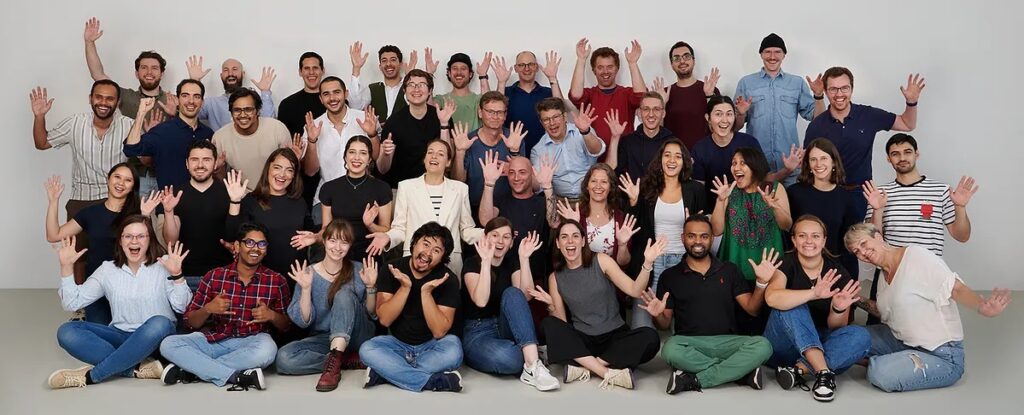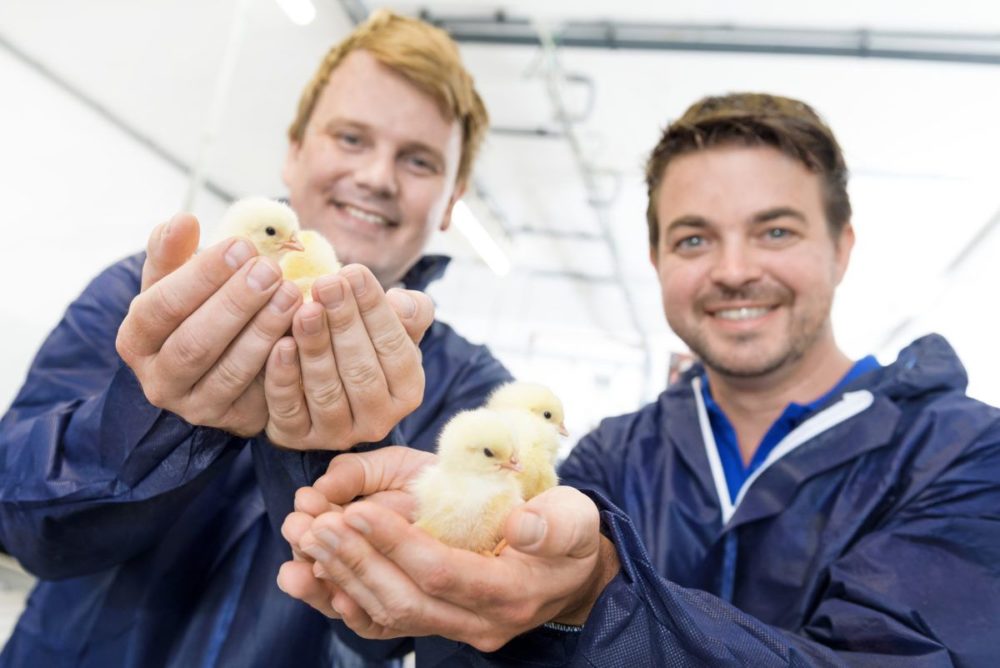New research from nonprofit Innovate Animal Ag (IAA) suggests that in-ovo sexing technology enabling hatcheries to determine the sex of chicks before they hatch has a market penetration of almost 15% in the EU, although it has yet to gain any traction in the US.
While the egg industry has been trying to end the practice for years, many consumers are unaware that it slaughters billions of male chicks every year… but not to put meat on the table.
Right now, hatcheries incubate billions of eggs, wait 21 days for them to hatch, hire trained ‘sexers’ to determine their sex, and then cull 50% of their chicks (via suffocation or grinding) because the males are of no use to the food industry. They can’t lay eggs, and there’s no market for their meat, as the breeds of chicken used in the egg and meat industries are different.
Ethics aside, this is bad for business and the environment, says IAA, which estimates that at least 56 million of the commercial EU layer population of 389 million hens were sexed with in-ovo sexing technology at the end of September 2023, indicating market penetration of almost 15% just five years after the technology was first commercialized in 2018.
New machines coming online
The 56 million-plus number — based on self-reported data from April 1, 2022 to Sept 30, 2023 from five companies who have commercialized in-ovo sexing —”is certain to continue to grow rapidly since many new machines were installed over the last 18 months,” predicts IAA.
“Orbem [a German company deploying MRI and AI to detect the sex of chicks at day 12] only commercialized in spring 2023 so their numbers reflect less than a year of production.
“There are also new machines that will come online in the near future including In Ovo’s circuit at Poppel in Belgium, Respeggt’s new circuit at Ankum in Germany, and Orbem’s machine in Dorum, Germany.
“And Orbem [which raised a $32 million series A in October] and In Ovo [which secured a $42 million loan from the European Investment Bank in November] recently received funding to scale up further.”
Egg-Tech Prize awards cash to Phase II finalists, but none yet meet all of its criteria
IAA’s research was released as the Foundation for Food & Agriculture Research (FFAR) and Open Philanthropy — organizers of the $6 million Egg-Tech Prize, a global competition to find high-tech solutions to end male chick culling — announced the three finalists for Phase II of their challenge:
- Leonard van Bommel, systems engineer, In Ovo (awarded $495,990): Dutch startup In Ovo tests allantoic fluid for a metabolite (the concentration of which differs between the sexes) using rapid mass spectrometry, enabling it to determine the sex of chicks with high accuracy on the ninth day of incubation.
- Dr. Carla van der Pol, research manager, HatchTech Group (awarded $499,331): HatchTech Group is a Dutch hatchery equipment manufacturer that owns Respeggt group and PLANTegg, which sample allantoic fluid from eggs to determine the sex of embryos at day nine of incubation. The Phase II money is for tech that extracts allantoic fluid at day eight and analyzes it with hyperspectral imaging and Raman spectroscopy. The light’s wavelength patterns reveal whether the developing chick is male or female.”
- Thomas Turpen, founder and CEO, SensIT (awarded $494,956): California-based startup SensIT uses a microchip-based chemical sensor that captures volatile organic compounds (VOCs) released from individual eggs as early as eight days into incubation. Machine learning can interpret the VOCs to classify eggs by gender.
According to FFAR, none of the Egg-Tech Prize finalists has yet been able to meet all the criteria, which include strict thresholds on speed/throughput (15,000 eggs/hour) and accuracy (98%+ at day eight or earlier) to create a “a scalable, commercially viable solution to male chick culling worldwide.”
However, all three finalists had made significant progress over the past 12 months, Nikki Dutta, scientific program officer at FFAR told AgFunderNews. “While the technologies did not meet all of the original evaluation criteria we wanted to give an additional opportunity to three finalists to continue to develop their technologies. After 12 months, they can re-present to us and a final award will be determined.”
Gene editing: ‘Consumer acceptance considerations’
Asked about FFAR’s decision to exclude firms using gene editing technologies from entering the Egg-Tech Prize, she said: “FFAR supports innovative research in several areas that seek to develop innovative and adoptable tools and technologies. However, for the Egg-Tech Prize, we’re really focused on providing solutions that can be utilized now.
“We want to invest in an adoptable technology where early accuracy, precision, sexing-determination is needed. There are also consumer acceptance considerations and unfortunately, in a number of those geographies, gene editing is currently not widely accepted.” (Click here to get a perspective on this from Israeli startup eggXYt, which claims its gene editing approach is “non-invasive, cost-effective, fast, and 100% accurate.”)

Proposals for EU-wide ban on male chick culling not included in recent revision of EC’s animal welfare legislation
But what is driving implementation of in-ovo sexing technology?
In Europe, regulatory interventions have spurred the industry into action, with Germany, France and Austria (with some exceptions) banning the culling of male chicks and Italy planning to phase it out by 2026. There has also been some activity in other markets without such regulations, notably Norway, with leading hatchery Steinsland & Co recently installing in-ovo sexing technology from Respeggt.
However, hopes that the European Commission would propose an EU-wide plan to phase-out male chick culling as part of a revision of EU animal welfare legislation were dashed last week when the EC released a proposal that did not mention the practice.
Joe Moran, director at the European policy office of animal welfare organization FOUR PAWS told AgFunderNews the omission of a concrete plan to phase out the “savage” practice was disappointing.
“The ruthless shredding and gassing of a-few-day old male chicks and female ducklings is yet another result of an outdated system that does not meet society’s values nor follow any real logic… We need strong EU legislative proposals to ban this cruel practice once and for all.”

The path to commercialization in the US
US producers, meanwhile, who are not under pressure from government to end the practice, have been slow to engage, with little pressure on companies to invest in solving a problem [male chick culling] that 89% of Americans do not know exists, according to IAA survey data.
United Egg Producers (UEP), which accounts for 90% of US egg production, called for the elimination of day-old male chick culling in 2016 but issued a statement five years later arguing that “a method that meets the food safety, ethical standards and scalable solutions needed for the United States is not yet available.”
In a recent email to AgFunderNews asking if its view had changed, a spokesperson said: “The UEP statement is still accurate as it stands.”
While mainstream egg producers may be watching and waiting for now, the “path to commercialization in the US starts at the high end of the market where consumers have shown they are willing to pay a price for higher quality, higher welfare organic or pasture-raised eggs,” IAA founder Robert Yaman told AgFunderNews.
And while current in-ovo sexing approaches add between 1-3 cents per egg to the retail price, the cost will go down over time, to the point where there is no cost once you factor in the savings from freeing up incubator space and not paying people to sex chicks, he claimed.

Sex determination techniques
Currently, in-ovo sex determination technologies can be grouped into six buckets, says Innovate Animal Ag:
1) Non-Invasive Imaging (already on the market): Looking through the shell of an egg to determine the sex of the embryo inside.
German firm Agri Advanced Technologies (AAT) — which has machines in seven hatcheries in six countries — uses hyperspectral imaging to determine the color of the embryo’s feathers, which can sex eggs of brown layers, since males and females have different colored feathers.
Dr. Anke Förster at AAT told AgFunderNews: “Our CHEGGY technology is based on hyperspectral imaging to detect gender specific differences in feather color of brown laying hybrids. Those differences can already be seen after 10 days of incubation, so a non-invasive, fast, and (cost-)efficient sorting of the eggs can be done between day 11 and 13 with high accuracy.
“Because the eggshell remains intact, hatchability loss is very low and hatcheries using this technology regularly calculate with only a small amount of extra hatching eggs per chick. CHEGGY not only conserves resources in terms of hatching eggs / viable embryos, but also in terms of (plastic and non-recyclable) waste, because no consumables are needed.
“The high throughput of a single machine of 20,000 eggs per hour makes sure that the normal hatchery routine is not changed significantly.”
Fellow German firm Orbem, meanwhile, combines AI with MRI (magnetic resonance imaging), to examine the organ development of embryos to detect physical differences between the males and females without penetrating the shell, and can work with brown and white layers. Marketing manager Mariana Pradillo told us: “This is our first year in the market and we now have three installations, two in France and one in Germany. A fourth one in the Netherlands is a work in progress.”
Omegga, another German startup, is developing a non-invasive technology where an imaging machine is installed directly inside the incubator to capture spectroscopic images over the course of several days, potentially working much earlier in the development process and eliminating the need to remove eggs from the incubator to be sexed, says Yaman at IAA.
While non-invasive imaging is fast, simple, and cheap, he says, the downside is that for the commercialized tech at least, you must wait until a relatively late stage in the embryo’s incubation (12 days) to ensure accuracy.
However, a study indicating that chicken embryos can’t feel pain before day 13 of incubation has prompted the German government to amend its legislation* on male chick culling to allow for in-ovo sexing up to and including day 12, which would permit imaging techniques such as those deployed by AAT and Orbem when the legislation comes into full force in January 2024.
*The German ban on male chick culling originally required producers to sex chicks by day six of incubation although no commercialized technology could determine the sex of an egg that early.
2) Allantoic sampling (already on the market): Extracting a drop of liquid from eggs around day nine of incubation and testing it for biomarkers that enable it to sex the egg.
This is a high-throughput approach currently commercialized in Europe through the Respeggt brand deploying technology from In Ovo, PLANTegg and Seleggt and highlighted on eggs sold in leading retailers including Carrefour, Rewe, and Edeka.
It is generally more expensive than non-invasive imaging, but can work earlier on in the incubation period.
3) Genetic editing: Using gene editing to give male embryos a genetic marker that allows them to be easily identified (eggXYt), or to stop growing entirely (Huminn). Only the males carry the genetic trait, so females and the eggs that make it into the supply are not genetically modified.
While any approach using genetic engineering can present regulatory or consumer challenges, it enables non-invasive, rapid sex detection before eggs enter the incubation process, whereas most other approaches are only viable several days into the incubation process.
4) Volatile analysis: Detecting sex-specific volatiles that escape through the eggshell.
5) Spectroscopic imaging: Taking images of embryos via tiny holes in the shell. This is more complex and expensive than non-invasive imaging but can be effective at an earlier stage of incubation, claims Yaman.
6) Sex reversal: Israeli firm SOOS Technology is exploring techniques including changing humidity, temperature, and sound vibrations to switch the sex of embryos from male to female, which if validated, would be an exciting solution, although the technique is still in its infancy.
According to a recent survey of 1,012 US egg buyers commissioned by Innovate Animal Ag and fielded by Nielsen Consumer Insights:
- 11% know about male chick culling; 48% think male chicks are raised for meat.
- 61% are uncomfortable with the practice of killing male chicks while 21% are comfortable; 73% agree the egg industry should find an alternative.
- 81% are unaware of in-ovo egg sexing technology, but 64% agree the egg industry should adopt it instead of culling male chicks.
- 47% are ‘extremely’ or ‘very’ interested in eggs produced using in-ovo sexing; another 35% (91 million) are ‘slightly’ interested.
- 71% are willing to pay a premium for eggs produced using in-ovo sexing. The median willingness to pay was just over 36 cents per dozen, which is the maximum price impact seen in Europe.
- The term ‘no-kill’ performed better than other potential terms for in-ovo egg sexing. Terms including the word ‘sex’ ranked poorly.




